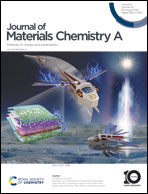A zincophilic ion-conductive layer with the desolvation effect and oriented deposition behavior achieving superior reversibility of Zn metal anodes†
Abstract
The commercialization of aqueous zinc batteries is severely hindered by the Zn metal anode due to its corrosion, parasitic reactions, and uncontrollable dendrite growth. Herein, a zincophilic ion-conductive layer that promotes desolvation and regulates the location of zinc deposition by depositing a ZnTe layer along the direction of ZnTe [111] on Zn foil is proposed to achieve high reversibility and stability of the Zn anode. The interaction of ZnTe with H2O promotes the desolvation of Zn(H2O)62+. Subsequently, ZnTe (111) provides ample diffusion channels for Zn2+ with high ionic conductivity (85 mS cm−1) and obstructs the transit of H2O, resulting in accelerated electrodeposition kinetics and inhibited side reactions. Besides, Zn tends to deposit as the flatter Zn (002) due to the highly matched hexagonal structure of ZnTe (111). Thanks to the above-mentioned optimization, an extremely high rate test (40 mA cm−2) is conducted with the ZnTe@Zn symmetrical cell, achieving an ultrahigh cumulative capacity of 19 000 mA h cm−2, which confirms the superior reversibility of the modified anode. The ZnTe@Zn‖α-MnO2 full cell exhibits an inspiring electrochemical performance as well. This zincophilic ion-conductive layer provides a promising idea for improving both the deposition kinetics and stability of the Zn metal anode.



 Please wait while we load your content...
Please wait while we load your content...